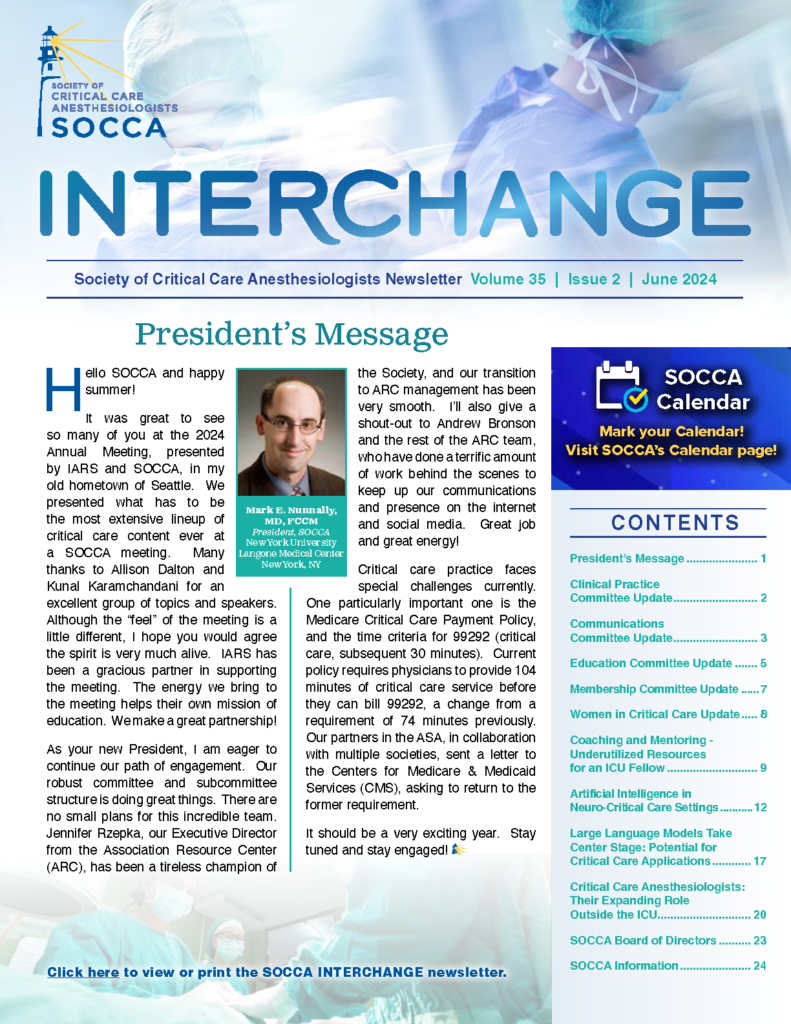The Importance of a Dedicated Intensive Care Unit (ICU) for the Critically Ill Obstetric (OB) Patient
Severe maternal morbidity in the United States has increased 200% from 1993-2014, with maternal mortality rising to a rate most recently estimated as 17.4:100,000 making this a major public health issue.1 Half of these deaths occurred in the beginning of the postpartum period and 60% of the total deaths were classified as preventable.1 This rate is subject to disparities with the incidence of severe maternal morbidity being higher in every racial and ethnic minority category compared to non-Hispanic white women.2 The most common etiologies of maternal mortality in the United States is cardiac disease, followed by hemorrhage, and then sepsis.3 These high-risk patients would benefit from a dedicated obstetric intensive care unit (OB ICU). Between 1-3% of pregnancies require an ICU admission based on studies in high income countries.4 This number is likely to rise with the increase in maternal morbidity and should prompt a consideration of the best way to deliver critical care to this special population.
As the maternal population ages and has an increasing number of comorbid conditions, we can expect that the need for more intensive monitoring and interventions will also rise. Caring for complex OB patients requires input from multiple disciplines including obstetricians, anesthesiologists, neonatologists, and other specialties including cardiology, pulmonology, hematology, neurology, and infectious disease. Although interdisciplinary input is imperative, the providers who care for pregnant patients on a regular basis and are familiar with obstetric medications, interventions, neonatal monitoring, and complications have a leading role in management. Obstetricians and obstetric anesthesiologists are the most experienced and well equipped to manage obstetric related issues in the immediate setting. Given the rarity of OB patients requiring ICU care, intensivists may not have the depth of experience with pregnant patients to acutely treat patients in labor and ICU staffing and unit acuity may present further challenges. Furthermore, most labor and delivery (L&D) suites have operating rooms in the immediate proximity that can facilitate emergent surgical delivery if needed - something that may not be available near a Surgical ICU (SICU). In a study of more than 500 women admitted to an ICU with severe acute maternal morbidity in France, 1 in 7 did not require any intervention for organ support and this suggests that an ICU admission may have been avoidable if a higher level of monitoring was possible on L&D.5
Keeping peripartum patients out of the ICU may also have advantages as it pertains to mental well-being and mother infant bonding. Mental health disorders are now coming to the forefront as a previously undescribed leading cause of death.6 Studies in the general population show that up to 35% of patients experience depression and/or anxiety and up to 20% of patients experience post-traumatic stress disorder while patients with pre-existing psychiatric disease are particularly at risk.7 One study in obstetrical patients showed that up to 20% of women who required ICU admission experience impaired quality of life 6 months after follow-up.8 If providing ICU care on L&D could facilitate keeping the mother closer to her child, this may have significant benefits in normalizing the birth experience, improving maternal fetal bonding, and breastfeeding.
Given these considerations, there are a growing number of advocates for management of high-risk patients on the L&D floor. This can be facilitated by approaches such as the Consultation, Surveillance, Monitoring, and Intensive Care (COSMIC) program.9 The COSMIC program directs higher levels of care resources to patients at risk of decompensation or complications. Women who meet certain diagnostic criteria associated with increased risk are referred to obstetric anesthesiologists; surveillance using automated systems to identify decompensation trigger team-specific early warnings; monitoring using a remote high-fidelity system allows for ICU telemedicine to enable peripartum management on the L&D floor with ICU oversight; and finally, a care pathway facilitating ICU admission for higher level monitoring and therapy offers a streamlined approach to critical care of these patients.9 Other approaches to maintaining the patient on the L&D floor with telemedicine could offer smaller facilities the capability of caring for complex patients using teleconsultation with a larger center staffed with full-time intensivist and maternal-fetal medicine physicians, however, this is an area in need of formal study.10
Although the management of critically ill patients on L&D shows promise, there are certain conditions and interventions that require admission to an ICU. Women with an increased risk of complications and/or those who develop severe illness should be managed at a level IV regional perinatal health center.11 This is important as obstetric care providers should ensure that an appropriate system of coordination is in place to support transfer to a higher level of care when indicated. The American College of Obstetricians and Gynecologists (ACOG) recommends that patients who require mechanical ventilation, aggressive hemodynamic support, ongoing hemorrhage, mechanical circulatory support, electrical instability, or have complicated conditions with organ failure require critical care in a full service ICU.10
Building an OB ICU requires a significant amount of preparation. A variety of factors should be taken into consideration such as the specific model and location of the ICU, bed availability, supplies and dedicated staff. Additionally, specialized knowledge in areas of maternal and fetal physiology is required to care for these patients successfully.
When considering the model of the OB specific ICU, one should consider if this will be a rural service-based model or a concurrent management model. Is the SICU an appropriate location for the OB ICU or would L&D be better to facilitate the management of these very sick patients? Management in a SICU gives the advantage of having available staff that are familiar with advanced monitoring such as arterial lines, central lines, swan catheters, titrating medications such as pressors and inotropes; on the other hand, the complex physiology of OB patients and the rarity of their critical OB pathology may result in the ICU staff having limited experience and knowledge required to manage them appropriately. Obstetricians, midwives, obstetric anesthesiologists, and L&D nursing staff are familiar with the OB management but may lack critical care management skills. So where do we go from here?
When building an OB specific ICU, it is important to have staff who are specialized in OB-specific physiology and pathology. The ideal intensivist should have an extensive background in OB and may include intensivist anesthesiologists with OB training or Maternal-Fetal Medicine Obstetricians with additional training in critical care as both are increasingly utilized pathways for intensivists who have a passion for OB critical care. The ideal nurse must possess both ICU and L&D experience as it is crucial to know how to manage invasive monitoring devices, titrate pressors and inotropes, and be familiar with obstetric medications. The bed availability may present a challenge at the hospital level, especially in level 1 trauma centers, however it is crucial to initially have two to three bed units reserved for the critically ill OB patient when constructing an OB-specific ICU. Communication between the departments of Anesthesiology, Critical Care, and Obstetrics and Gynecology is crucial to set up goals, expectations, appropriate training, and recruitment of new staff as well as providing extra training to the current employees. Simulations and standardized scenarios have been proven to increase knowledge, awareness and enhance the educational experience of personnel in specific topics.12
Is there an advantage to creating an OB specific ICU? The increasing maternal morbidity and mortality mandates the provision of more specialized care to these critically ill patients. Cardiac disease is the primary cause of maternal mortality in the United States. Patients with cardiac arrest, peripartum cardiomyopathy, and/or amniotic fluid embolism may need to be placed on mechanical support as a bridge to recovery and sometimes as a bridge to transplant. In the event that these rare cases occur, it is essential to have healthcare professionals available who can manage the complexity of their pathology and improve outcomes. The COVID-19 pandemic affected all populations across the world including peripartum patients and the nuances of managing a pregnant patient through mechanical ventilation, rescue therapies, and even extracorporeal membrane oxygenation requires expert knowledge for optimal outcomes of mother and baby. And despite the fact that hemorrhage is no longer the primary cause of maternal mortality in the United States, there is still a significant gap in knowledge when it comes to the resuscitation of the OB patient in the critical care setting.
In light of all this, the Society of Critical Care Anesthesiologists (SOCCA) has decided to create a new sub-committee, the Obstetric Critical Care task force under the leadership of Dr. Angelidis and Dr. Naoum with the goal to raise awareness on OB critical care issues that are heavily underrepresented in the annual meeting. Recently, SOCCA and the Society of Obstetric Anesthesiology and Perinatology (SOAP) have decided to join forces and collaborate with the goal to inform, discuss, and present OB ICU knowledge in annual national conferences for both professional fields with the additional hope to inspire more professionals to consider the avenue of OB Critical Care.
References:
- Centers for Disease Control and Prevention. Severe Maternal Morbidity in the United States. Accessed February 26, 2023, https://www.cdc.gov/reproductivehealth/maternalinfanthealth/severematernalmorbidity.html
- Admon LK, Winkelman TNA, Zivin K, Terplan M, Mhyre JM, Dalton VK. Racial and Ethnic Disparities in the Incidence of Severe Maternal Morbidity in the United States, 2012-2015. Obstet Gynecol. Nov 2018;132(5):1158-1166. doi:10.1097/aog.0000000000002937
- Creanga AA, Syverson C, Seed K, Callaghan WM. Pregnancy-Related Mortality in the United States, 2011-2013. Obstet Gynecol. Aug 2017;130(2):366-373. doi:10.1097/aog.0000000000002114
- Walsh EC, Naoum EE. Escalating Care on Labor and Delivery. Anesthesiol Clin. Dec 2021;39(4):667-685. doi:10.1016/j.anclin.2021.08.002
- Godeberge C, Deneux-Tharaux C, Seco A, Rossignol M, Chantry AA, Bonnet MP. Maternal Intensive Care Unit Admission as an Indicator of Severe Acute Maternal Morbidity: A Population-Based Study. Anesth Analg. Mar 1 2022;134(3):581-591. doi:10.1213/ane.0000000000005578
- Mangla K, Hoffman MC, Trumpff C, O'Grady S, Monk C. Maternal self-harm deaths: an unrecognized and preventable outcome. Am J Obstet Gynecol. Oct 2019;221(4):295-303. doi:10.1016/j.ajog.2019.02.056
- Prince E, Gerstenblith TA, Davydow D, Bienvenu OJ. Psychiatric Morbidity After Critical Illness. Crit Care Clin. Oct 2018;34(4):599-608. doi:10.1016/j.ccc.2018.06.006
- Seppänen PM, Sund RT, Ala-Kokko TI, Uotila JT, Helminen MT, Suominen TM. Health-related quality of life after obstetric intensive care admission: Comparison with the general population. J Crit Care. Feb 2018;43:276-280. doi:10.1016/j.jcrc.2017.09.034
- Lockhart EM, Hincker A, Klumpner TT, et al. Consultation, Surveillance, Monitoring, and Intensive Care (COSMIC): A Novel 4-Tier Program to Identify and Monitor High-Risk Obstetric Patients From the Clinic to Critical Care. Anesth Analg. Jun 2019;128(6):1354-1360. doi:10.1213/ane.0000000000004141
- ACOG Practice Bulletin No. 211: Critical Care in Pregnancy. Obstet Gynecol. May 2019;133(5):e303-e319. doi:10.1097/aog.0000000000003241
- Kilpatrick SJ, Menard MK, Zahn CM, Callaghan WM. Obstetric Care Consensus #9: Levels of Maternal Care: (Replaces Obstetric Care Consensus Number 2, February 2015). Am J Obstet Gynecol. Dec 2019;221(6):B19-b30. doi:10.1016/j.ajog.2019.05.046
- Seam N, Lee AJ, Vennero M, Emlet L. Simulation Training in the ICU. Chest. Dec 2019;156(6):1223-1233. doi:10.1016/j.chest.2019.07.011





































